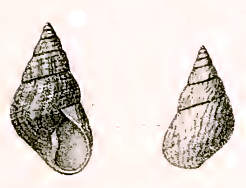Phasianotrochus irisodontes facts for kids
Quick facts for kids Phasianotrochus irisodontes |
|
|---|---|
 |
|
| Drawing with two views of a shell of Phasianotrochus irisodontes | |
| Scientific classification | |
| Synonyms | |
|
The Phasianotrochus irisodontes is a type of sea snail. It is also known as the maireener, rainbow kelp shell, or green necklace shell. This amazing creature is a gastropod mollusk that belongs to the family Trochidae, often called the "top snails."
These snails are found off the coast of Tasmania, Australia. Their beautiful shells have been used for thousands of years. Aboriginal Tasmanian women traditionally make stunning necklaces from them. Sadly, the number of these snails has been going down. This is due to things like climate change and human activities near the coast.
What Does the Maireener Shell Look Like?
The shell of the maireener snail is usually between 10 and 20 millimeters tall. That's about the size of your fingernail! It has a pointed, solid shape, like a cone that's stretched out. The shell is very shiny and can be yellowish, pink, or olive-green.
You might see reddish or olive-colored lines running down the shell. Sometimes, there are also many thin, faint spiral lines that are pink or yellowish. Some shells even have small white dots on the upper part. The top, pointed part of the shell, called the spire, is shorter than in some other similar snails.
The shell has about seven whorls, which are the turns or spirals of the shell. These turns are only slightly curved. The main body part of the shell is smooth on top and has fine lines underneath. The opening of the shell, called the aperture, is quite large. Inside, it's smooth and lined with a bright, shiny green material called nacre, which is like mother-of-pearl. The central pillar inside the shell, called the columella, has a strong tooth-like bump at the bottom. The colors of these shells can vary a lot, with some even being completely green.
Where Do Maireener Snails Live?
These marine snails are endemic to Australia. This means they are only found there! You can find them in the waters off South Australia, Tasmania, Victoria, and Western Australia. They live in the ocean in areas called the subtidal and lower intertidal zones. The subtidal zone is always covered by water, while the lower intertidal zone is only exposed to air during very low tides.
Unfortunately, the number of maireener snails has been decreasing recently. Scientists believe this is happening for a few reasons. One reason is that human activities, like recreational boating, can reduce the amount of kelp habitat where these snails live. Kelp is a type of large seaweed that provides food and shelter. Another issue is predatory fish. These fish are sometimes attracted by extra food escaping from nearby abalone farms. Also, strong storms can erode the seabed, which damages the snails' homes.
The Art of Shell Necklaces
For at least 2,600 years, Tasmanian Aboriginal women have been creating beautiful shell necklaces using maireener shells. This practice is a very important part of their culture and history. Many of these amazing necklaces are now kept in museums as valuable art pieces.
However, the future of this ancient tradition is now at risk. Because the number of maireener snails is going down, it's becoming harder to find enough shells to make the necklaces. Lola Greeno, a Palawa woman who is a 6th-generation shell necklace maker, is worried. She fears that if the supply of shells continues to drop, this special cultural practice might disappear. Efforts are being made to protect the snails and ensure this important tradition can continue for future generations.

